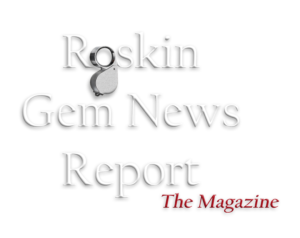What is reviving China”‘s Jade Trade? According to Designer Eunice Zhang, Gen Z Consumers
From bargain hunting via live broadcasts to collecting at auction houses, young Chinese shoppers are taking up the banner of jade consumption. – Subscription Only
By Shumin Lai
August 19, 2024
Vogue Business Magazine
You do not have to be in the business of Jade to find so many important perspectives here that can help you in your own business. Recognizing who your clients are, what they can afford, and where they want to buy, helps jewelry designers make their mark. – gr
Soon after graduating from medical school, Eunice Zhang began buying jade jewellery worth 10s of thousands of yuan. She earned a professional qualification as a gemologist and a jade appraiser, and in 2019, she founded her brand and opened two accounts on Xiaohongshu, where she hosted live broadcasts selling jade jewellery.
Her jade pieces span in price from around RMB 500 to 10s of thousands (£54 to £1000s). Some of her older customers are willing to spend hundreds of thousands or millions of yuan to invest and collect jade. But it”‘s the younger audiences that are coming in droves – buying the lower-priced pieces, but buying often. Zhang likens the jade market to a “short and fat” pyramid, with the cheaper pieces at the bottom being the most popular.

Photo: Courtesy of Qeelin
The semi-precious green stone has long been one of the most popular in China, but fresh product styles and modern selling practices are introducing jade jewellery, like bangles and pendants, to new and younger audiences. Live broadcast e-commerce channels have replaced stores to become the main shopping channel for jade sales. Currently, the prominent sales platforms for jade are Douyin, Kuaishou, Xiaohongshu and Bilibili.
Sales of the stone increased by 15.8 per cent in 2023, with a market size over RMB 150 billion (approximately £16.2 million) – making it China”‘s second largest jewellery category after gold, according to Mintel. And customers are getting younger: as of 2021, 25 to 34-year-olds account for 44 per cent of jade purchases.
Part of the reason? Celebrity fans. An increasing number of Chinese celebrities, including actors Guan Xiaotong, Yang Mi, Yang Zi and Zhou Dongyu, have been photographed wearing jade. The stone”‘s vast price spectrum – reflecting water content, colour and type – also means that customers can buy in without breaking the bank.
Collectors vs Customers
Jade collectors are also getting younger. Phillips auction house, founded in 1796 with an HQ in Hong Kong, has long dealt jade pieces. “In the auction field, collectors establish their own unique collection system around the age of 35,” says Chen Zhiqing, head of auction at its Hong Kong jewellery department. “Some young collectors will gradually turn to jade jewellery if they have the budget. We consider collectors aged 35 to 40 to be relatively young.” Zhiqing adds that jade”‘s appeal lies in its quality, vast selection and price advantage.
Phillips holds four jewellery auctions a year, each featuring around 20 jade items. In line with the trend of young collectors, the house tends to select jade jewellery suitable for everyday wear, with prices ranging from 10s of thousands to millions of Hong Kong dollars (approximately £990 to £100,000s).
New designs for new audiences
Product styles are changing to attract the younger jade consumer. Where their parents”‘ generation purchased jade pendants or bracelets carved with Buddha statues, today”‘s customer prefers simpler and personalised designs that highlight the texture of the stone itself, and are lighter in shade.
Loewe recently commissioned master jade carvers Xiaojin Yin, Lei Cheng and Qiu Qijing to create a series of limited-edition pendants to celebrate the 2024 Lunar New Year. Qijing says he drew inspiration from the shape of each stone: “Each has its own natural characteristics, so we have to follow its momentum. Many works are very beautiful in the beginning, but once you adjust them, often the colour can change or cracks appear.”
Then, there are the younger collectors who prefer antique jade that feature fine carvings. “Some jade removed from old jewellery may have a different texture and charm after being inlaid and processed with new techniques. This is another trend worth paying attention to,” Zhiqing adds.
Of all the jade auction items that Zhiqing has come across, the one that impressed her the most was a bracelet crafted from natural jade beads, red tourmaline and diamonds. “In the past, jade beads were more classic and traditional, in line with the aesthetic of ‘old money style”‘. This jade collection had a more modern design, the kind that makes collectors”‘ eyes light up,” she says.
Jade jewellery designers also become influenced by Western styles and behaviours. For example, Zhang puts a diamond-studded ring around the jade beads, which mimics a 3D jade-like planet from a distance. Pet lovers prefer jade pendants in the shape of cat paws. Jewellery brand Qeelin has followed the local style trend of combining jade with traditional Chinese symbols such as Ruyi locks, bamboo and gourds.
In step with demand, and thanks to changing trends and a shortage of raw materials, the price of jade could begin to rise across all varieties. But don”‘t expect the popularity of jade – steeped in Chinese history – to fade. Whether it”‘s looking for deals on live broadcasts or bidding at auction houses, the appetite for jade is only growing.
Tap here for more feature stories from Vogue Business Magazine













